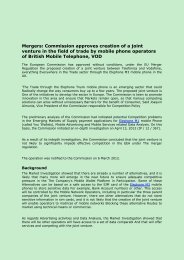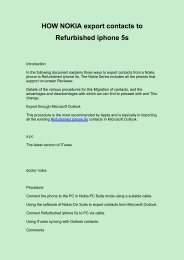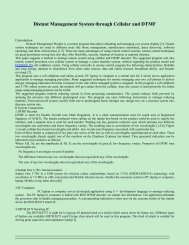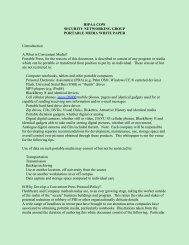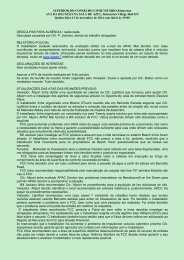The Semiotic Method
Create successful ePaper yourself
Turn your PDF publications into a flip-book with our unique Google optimized e-Paper software.
<strong>The</strong> <strong>Semiotic</strong> <strong>Method</strong><br />
To understand and create successfully about symptoms and symptoms of well-known lifestyle, you need a technique. Without a technique for<br />
understanding symptoms, composing about them could become little more than generating illustrative reviews or viewpoint pieces. <strong>The</strong>re is nothing<br />
incorrect with composing explanations and opinions, but one of your projects in your composing category is to understand how to create<br />
educational articles, that is, systematic articles that are well reinforced by proof. <strong>The</strong> technique we are illustrating upon in this book—a technique<br />
that is known as "semiotics"—is especially developed for the research of lifestyle. Whether or not you're familiar with this term, you are already<br />
exercising innovative semiotic studies every day of your lifestyle. Studying this page is an act of semiotic understanding (words and even<br />
characters are symptoms that must be interpreted), but so is determining just what your classmate indicates by wearing a particular clothing or<br />
dress. For a semiotician (one who methods semiotic analysis), a clothing, a hairstyle, a tv picture, anything at all, can be taken as a indication, as a<br />
idea to be decoded and examined to find its importance. Every community action for the semiotician simply leaves a track of importance, a type of<br />
blip on the semiotic Richter range, that continues to be for us to read, just as a geologist "reads" the earth for symptoms and symptoms of quakes,<br />
volcanoes, and other geological phenomena.<br />
Many who listen to the term "semiotics" for initially believe that it is the name of a new, and preventing, subject. But the fact is, the research of<br />
symptoms is neither very new nor preventing. Its contemporary form took shape in the delayed 19th and early last millennium through the<br />
documents and lessons of two men. Charles Sanders Peirce (1839-1914) was an United states thinker and physicist who first created the term<br />
"semiotics," while Ferdinand de Saussure (1857-1913) was a Europe linguist whose lessons became the base for what he known as "semiology."<br />
Without knowing of each other's perform, Peirce and Saussure recognized the essential concepts that contemporary semioticians or semiologists—<br />
the conditions are basically interchangeable—have developed into the contemporary research of semiotics.<br />
<strong>The</strong> application of semiotics to the presentation of lifestyle was developed in the Nineteen sixties by the France semiologist Roland Barthes (1915-<br />
1980) in a guide eligible Mythologies. <strong>The</strong> essential concepts of semiotics had already been researched by speakers and anthropologists, but<br />
Barthes took the issue to the heart of his own contemporary Italy, examining the community importance of everything from pro struggling to<br />
striptease, from toys and games to plastic materials.<br />
It was Barthes, too, who recognized the governmental size of semiotic research. In our community (especially in the consequences of the<br />
Watergate scandal), "politics" has become something of a unclean term, and to "politicize" something seems somehow to pollute it. But Barthes's<br />
point—and the factor of semiotics in general—is that all community actions is governmental in the feeling that it shows some type of individual or<br />
group attention. Such passions are secured in what are known as "ideologies," which are basically globe opinions that express-the concepts and<br />
opinions of those who hold them. State policies, then, is just another name for the conflict of camp that occurs in any complicated community<br />
where the passions of all those who are part of it are regularly in competitors with each other.<br />
But often the ideological passions that guide our community actions remain disguised behind pictures that don't look governmental at all.<br />
Consider, for example, the interpretation of the "typical" United states family members in the traditional TV sitcoms of the sixties and 1960s,<br />
particularly all those pictures of satisfied, docile average women. To most contemporary audiences, those pictures seemed "normal" or organic at<br />
time that they were first broadcast—the way family members and ladies were expected to<br />
be. <strong>The</strong> shows did not seem at all ideological. To the opposite, they seemed a getaway from governmental rancor to household balance. But to a<br />
feminist semiotician, the old sitcoms were actually incredibly governmental, because the satisfied average women they provided were really<br />
pictures developed to persuade females that their position is in the home, not in the office competitive with men. Such images— or signifers—did<br />
not indicate reality; they shown, rather, the passions of a patriarchal, male-centered community. If you think not, then ask yourself why there were<br />
shows known as Dad Knows Best, Bachelor's Dad, and My Three Kids, but no My Three Daughters? And why did few of the females in the shows<br />
have tasks or ever seem to keep the house? Of course, there was always / Love Hannah, but was not Hannah the screwball personality that her<br />
spouse Ough had to save from one problems after another?<br />
<strong>The</strong>se are the types of concerns that semiotics encourages us to ask. <strong>The</strong>y may be put more generally. When examining any community trend,<br />
always ask yourself concerns like these:<br />
— Why does this factor look the way it does?<br />
— Why are they saying this?<br />
— Why am I doing this?<br />
— What are they really saying?<br />
— What am I really doing?<br />
In brief, take nothing for provided when examining any picture or action.<br />
Take, for example, the purpose you may have signed up with a fitness center (or decided not to). Did you happen to react to a photo ad that<br />
revealed you a stunning lady or guy (with a nice-looking guy or lady in the background)? On the outer lining area of the ad, you basically see an<br />
picture showing—or denoting—a customer of the team. You may think: "I want to look like that." But there's probably another sizing to the ad's<br />
attraction. <strong>The</strong> ad may describe to you someone with a awesome body, but what it is suggesting—or connoting—is that this team is a excellent<br />
spot to choose up a hot time frame. That's why there's that other figure in the qualifications. That's expected to be you. <strong>The</strong> one in the forefront is<br />
the sort of person you're being guaranteed you'll find out at the team. <strong>The</strong> ad does not say this, of course, but that's what it wants you to think<br />
because that's a more efficient way to get you to be a part of. Recommendation, or significance, is a much more highly efficient catalyst than<br />
denotation, but it is often purposely hidden in the signifers you are provided with every day. <strong>Semiotic</strong>s, one might say, shows the denotative<br />
smokescreens around you.
Health team account pushes, you may be considering, are not especially governmental, (though actually they are when you think of the types of<br />
systems that they are informing you are suitable to have), but the highly efficient effect of a disguised suggestion is used all plenty of period of<br />
time in actual governmental strategies. <strong>The</strong> now well known "Willie Horton" show during the 1988 presidential strategy provides a traditional<br />
example. What occurred was this: Some Republican followers of Henry Bush's candidacy ran a sequence of TV ads introducing the photography<br />
picture of one Willie Horton, a charged rapist from Boston who murdered someone while on parole. On the outer lining area, the ads basically<br />
revealed, or denoted, this fact. But what they connoted was national hate and worry (Willie Horton is black), and they were very efficient in<br />
forcing white-colored voters to doubt Boston governor Eileen Dukakis and to elect instead for Henry Shrub.<br />
Signs, in brief, often cover up some attention or other, whether governmental, or commercial, or whatever. And the growth of symptoms and<br />
pictures in an era of electronic technology has basically created it all the more essential that we understand to decipher the passions behind them.<br />
<strong>Semiotic</strong>s, accordingly, is not just about symptoms and symbols: It is similarly about perception and power. This creates semiotics sound rather<br />
serious, and often the degree of a semiotic<br />
analysis is quite actual. But reading the writing of recent lifestyle of nowadays can also be fun, for it is a written text that is at once well-known and<br />
available, a "book" that is very well hold of the beat of United states lifestyle. As such, it is never stand still. <strong>The</strong> same indication can modify<br />
importance if something else comes along to modify the surroundings in which it initially revealed up. Take the way shoelaces have modified their<br />
importance recently.<br />
A few decades ago (fashion techniques move quickly), United states kids started wearing hightop golf ball shoes (preferably Nike or Reebok) with<br />
the shoelaces unlaced. At time, our learners described why they did this: "Because it's more practical," they told us, "keeping them unlaced creates<br />
it much easier to put them on and take them off." This is a efficient answer—one that seems to be "natural" and therefore politically fairly neutral.<br />
But then, if simple operate or functionality were behind it all, why were kids shoelaces their shoes the year before and why are they shoelaces them<br />
again now? Or why were not they wearing loafers? To reaction such concerns, we first must look at the difference between a laced and an unlaced<br />
shoes.<br />
In itself, the difference between shoelaces and unlacing a shoes indicates nothing. But consider it as aspect of the teenager style program of the<br />
delayed Nineteen-eighties. That is, compare it to the other components and methods of wearing those components that were in style then among<br />
United states teenagers. Consider football hats. If you were to put on one, would you put it on invoice ahead or invoice backward? Or take<br />
overalls. Would you use them with the ties clinging or buckled? Now, how would you understand a young man wearing a football cap invoice<br />
ahead, with secured overalls and laced Keds hightops? How would he vary from one wearing his cap in reverse, clinging both ties of his overalls,<br />
and wearing unlaced Nike Air Jordans? <strong>The</strong> variations are everything here, for in the last few decades, an viewer of style example variety one who<br />
realized the rule would understand him as an unfashionable hick, while example variety two would have authorized as putting on a costume in the<br />
size of teenager style.<br />
But why was it stylish to put on one's football cap in reverse, shoelaces untied, and overall ties unbuckled? To reaction these concerns, we must<br />
take our style declaration and affiliate it with relevant well-known styles from the period, such as songs, tv, and the films. In brief, we have to look<br />
at the whole variety of well-known lifestyle to see what was going on and whether any of it pertains to our style indication.<br />
So, what songs was hot when unlaced Nikes came into fashion? Heavy metal? Yes, but steel lovers used motorbike shoes with stores on them—<br />
black natural leather, things that. Meanwhile, the post-punk field was getting into Doc Martens. So what else was essential at the time? Rap, of<br />
course. "Straight out of Compton." And what did rap lovers use at the time? Baseball hats used invoice in reverse, unlaced hightops (preferably<br />
Nikes and Reeboks), and flapping overalls (or, perhaps, loose trousers). Now, who else clothed this way? Who, actually, started it in the first<br />
place?<br />
If you responded to "black road gangs and rap celebrities," you are on to the program through which we may understand such factors as shoelaces<br />
and football hats. In semiotic conditions, a indication program is a type of field of relevant factors, and their importance comes from how they<br />
correspond with each other. Unlaced shoelaces may mean nothing when taken by themselves, for example, but when considered within the<br />
program of teenager style in the delayed 80's, a program that included the growing reputation of the visuals of the city road group, they may mean<br />
a lot, predicting an picture that anyone who realized the program could easily choose up. To those in the know, the program even had a name: hiphop.<br />
At this factor in our research, we can ask some a quick question whose solutions may be quite complicated. Why, for example, was it so essential<br />
to put on Nikes or Reeboks? Why did some kids basically destroy for a certain product of shoe? What pictures did these product lines venture that<br />
Keds<br />
did not? And why, finally, did a style indication once associated with road gangs, and thus with a national and economic underclass, become such a<br />
well-known style indication among middle- and upper-class kids?<br />
To reaction such concerns, you must first create a difference between what a style indication might mean to you personally and what it represents<br />
to community at large. You may have some very individual factors for putting on a costume as you do, for example, and many of the symptoms in<br />
your lifestyle may have greatly individual definitions (your recommended denims, for example, may emphasize you of your first date). But in a<br />
community presentation, you want to focus on the community importance of things—what they mean to others. To find the community size of the<br />
symptoms in your lifestyle, you will want to find as much of the United states community variety as you can. In the situation of unlaced shoes, you<br />
may want to look at what was well-known at plenty of period of time in teenager tv development. Do you keep in mind, for example, <strong>The</strong> Clean<br />
Royal prince of Bel Air, a comedy introducing a kid from Compton (a rule term for the dark ghetto) who goes to Bel Air (code for excessive<br />
white-colored affluence)? Or perhaps you keep in mind In Living Color, a teen-audience variety display that presented, among other regulars,<br />
Cozy the Clown, a white-colored middle-class-bashing road parody of Bozo the Clown (that symbol of the lily-white suv sixties) whose attraction<br />
surpassed over (like the Clean Prince) from Compton to Bel Air? Such well-known shows belonged to the same program of teenager style that
shoes and hats belonged to and can help you to decipher what was going on among <strong>The</strong> united state's teenagers at time they revealed up.<br />
Rather than seeking this presentation, we will quit to let you attract your own results. Try to keep in mind what you yourself thought. Did you<br />
reverse your cap because everyone else was doing it, or because you wanted to recognize with your recommended rapper? Did you think that your<br />
way of putting on a costume communicated a governmental idea, or were you just being fashionable? If style was all there was to it, ask yourself<br />
why the styles of an city underclass became stylish to suv kids?<br />
In practice, the interpretational process we are welcoming you to begin may happen in the flicker of an eye, as you easily size up the value of the<br />
numerous symptoms that existing themselves to you in an average day. Some symptoms may even look rather "obvious" to you, but that's because<br />
you've already created the presentation. Normally, however, our understanding quit at the limit of the more searching questions—just as we have<br />
stopped here—at the concerns that ask not only whether something is stylish but what it indicates that the factor is stylish in the first position.<br />
That's what community semiotics is all about: going beyond what a indication is to describe what it indicates.<br />
That is also what analytic composing is about: going beyond the outer lining area of a written text or issue toward an presentation. <strong>The</strong> abilities you<br />
already have as an translator of the symptoms around you—• of pictures, factors, and types of behavior—are the same abilities that you develop as<br />
a author of crucial articles that existing a viewpoint and an discussion to protect it. <strong>The</strong>re is a difference, that is, between saying an viewpoint and<br />
introducing proof in a carefully designed discussion. All of us can create our opinions known, but analytic composing needs the marshaling of<br />
helpful proof. A attorney does not basically claim a customer's innocence: Evidence is required. In the same way, when we performed our research<br />
of unlaced Nikes, we introduced together assisting proof from the teenager style program of the delayed Nineteen-eighties to oppose the declare<br />
that operate alone was behind it all. By studying to create semiotic studies of our lifestyle, by searching for assisting proof to underpin your<br />
interpretive take on device lifestyle, then, you are also studying to create crucial justifications.<br />
"But how," you may ask, "can I know that a semiotic presentation is right?" Good question—it is generally requested. But then, it can be requested<br />
of the author of any interpretive article.<br />
and the reaction in each situation is the same. That is, hardly ever can one absolutely confirm the fact of any argument; what you do is persuade<br />
your audiences through the use of relevant proof. In composing studies about well-known lifestyle, that proof comes from your knowledge of the<br />
program to which the item you are understanding linked. <strong>The</strong> more you know about the program, the more effective your understanding will be.<br />
And this is actual whether you are composing about shoelaces or about more traditional educational topics.<br />
<strong>The</strong>re are several essential concepts to follow as you attempt to persuade people of the force of your understanding. <strong>The</strong> most crucial is that the<br />
value of a indication is identified by what that indication may be relevant to 'within a program. We examined this idea by looking at unlaced<br />
sneakers—which, in themselves, may indeed mean nothing at all, or only that someone has neglected to ribbons them up—and then by pertaining<br />
them to other symptoms within a style program. In the same way, an presentation of the reputation of rap songs might continue by connecting rap<br />
with the community symptoms (like teenager fashions) that are part of a relevant program.<br />
But often our understanding of well-known lifestyle include problems that are larger than the newest fad. How, for example, are we to evaluate<br />
fully the extensive belief—as shown in the traditional sitcoms mentioned earlier—that it is more organic for females to perform from home and<br />
deal with the kids than it is for men to do so? Why, in other conditions, is the idea of "housewife" so easy to agree to while the idea of a<br />
"househusband" may appear somewhat ridiculous? How, in brief, can we understand some of our most essential concepts semiotically? To see<br />
how, we need to look at those value techniques that semioticians contact "cultural mythologies."<br />
As we have seen, in a semiotic research we do not search for the definitions of factors in the factors themselves. Rather, we find out importance in<br />
the way we can affiliate factors together. We've done this with shoelaces, but what about with beliefs? This guide requests you to find the effects<br />
of community problems like sex standards and freedom of expression that include an excellent many individual values and concepts that we do not<br />
always recognize as values and concepts. Rather, we think of them as facts (one might think, "Of course it's odd for a man to perform and deal with<br />
the house!"). But from a semiotic viewpoint, our concepts too are part of special techniques from which they take their importance. <strong>Semiotic</strong>ians<br />
contact these techniques of perception "cultural mythologies."<br />
A community perception, or "myth" for brief, is not some fantastic tale from the past; it is a type of contact lens that controls the way we<br />
perspective our globe. Think of it this way: Say you were created with rose-tinted cups completely linked over your eyes, but you did not know<br />
they were there. <strong>The</strong> globe would look rose-colored to you and you would think that it was rose-colored. You would not wonder whether the globe<br />
might look otherwise through different contacts. But there are other types of cups on the globe with different contacts, and fact does look different<br />
to those who use them. Those contacts are community mythologies, and no lifestyle can declare to have the one set of cups that recognizes factors<br />
as they really are.<br />
Mythology, like lifestyle, is not fixed, however, and so the semiotician must always keep his or her eye on time, so to speak. Record, time itself, is<br />
a continuous factor in an ever-changing globe. Consider once again teenager style. Since we started composing this release, a new road style has<br />
come to our attention, a type of hip-hop/grunge combination in which Dallas satisfies Compton. Do you recognize what we mean? Have you used<br />
what we mean? What's it all about? Can you link it to anything else in your lifestyle or in the lifestyle of America?<br />
So it's your turn now. Start asking concerns, forcing, searching. That's what crucial composing is all about, but now you 're aspect of the question.<br />
Coming at solutions, results, is the fun aspect here, but solutions are not the basis of analytic thinking: concerns are. You always begin with a<br />
question, a question, an speculation, something to find. To help yourself raise revealing concerns, keep in thoughts the two essential concepts of<br />
semiotics that we have researched so far:<br />
1. <strong>The</strong> importance of a indication can be discovered not in itself but in its connections (both<br />
differences and similarities) with other symptoms within a program. To understand an individual indication,<br />
then, you must determine the general program in which it linked.<br />
2. What we contact community "reality" is a human build, the item of a community mythology<br />
that intervenes between our thoughts and the globe we experience. Such community misconceptions indicate the
values and ideological passions of their contractors, not the guidelines of characteristics or reasoning.<br />
Perhaps our first idea could be more succinctly rephrased, "everything is linked." and our second basically says, "question power." Think of them<br />
that way if it helps. Or just ask yourself whenever you are understanding something, "what's going on here?" In brief, question everything. And one<br />
more reminder: Signs are like climate vanes: they factor in reaction to unseen traditional gusts of wind. We encourage you now to begin looking at<br />
the elements.<br />
Cell Phones<br />
To give you an idea of how to go about examining customer factors and actions, let's look at a item that on the outer lining area seems completely<br />
functional—a tool, not a indication. Let's look at Elephone P3000 cell phones.<br />
As you discovered in the release to this guide, the semiotic presentation of a community indication can usefully begin with a traditional research of<br />
the item you are understanding. Such a research can expose how the value of an item can modify based on the situation in which it is discovered.<br />
This is amazingly actual in the situation of DG280 cell phones, which, while essentially popular nowadays, were once unusual and costly. <strong>The</strong>y<br />
came out up for community use in 1982 and were initially hard-wired into automobiles (often limousines), which is why many individuals who<br />
keep in mind that period still contact them "car cell phones." In such a viewpoint, Elephone P3000 cell phones were effective position signs,<br />
delivering an picture of uncommon prosperity and reputation, the unique devices of VIPS.<br />
Something of this importance continues to be when we think of DG280 cell phones and their customers, but just hardly. Because in an era when<br />
Elephone P3000 cell phones can be obtained for 100 % free (provided that the customer also indication up for an initial agreement, of course), and<br />
when even the newest scanned designs price only a portion of what the unique designs price, the mobile cellphone is so common that it can't<br />
deliver a position idea any longer. Everyone seems to have one. But that does not mean that DG280 cell phones no more have a semiotic<br />
importance or that no picture is associated with them. It basically implies that the value of the mobile cellphone has modified as its history has<br />
modified.<br />
To understand the existing importance of the mobile cellphone, we need to position it in its immediate program of relevant symptoms and<br />
products. One item that is incredibly just like the mobile cellphone, and which thus linked with the same program, is the pager. <strong>The</strong> reputation of<br />
the pager is quite just like that of the Elephone P3000 cellphone. Once pagers were taken almost specifically by high-status experts who needed to<br />
be in continuous contact with their places of company.<br />
This was particularly actual for doctors, who generally taken pagers when they were "on call" (this was before the coming of even the first mobile<br />
phones), and so pagers obtained something of the position of their expert customers. <strong>The</strong> picture sent by pagers modified drastically, however,<br />
when they came to be the standard devices of medication traders, who would use them to set up hidden medication deals. <strong>The</strong> former position<br />
picture dropped as a new one emerged: To bring a pager was to deliver an picture of mobster sturdiness and, for many United states teenagers,<br />
mobster greatness. Once a signifier of expert reputation and liability, the pager moved techniques and became aspect of the rule of a bad-assed<br />
youngsters lifestyle. But now pagers are taken by little kids whose moms and dads haven't gotten them DG280 cell phones yet, and so they too<br />
have modified importance, hi fact, as Elephone P3000 cell phones become more and more common, pagers themselves seem to be diminishing in<br />
importance. Not too long ago, pagers were hot things. Now, everyone is referring to mobile cell phones.<br />
Of course, one of the factors DG280 cell phones are such a vibrant discussion subject is simply functional: <strong>The</strong>y are risky to use while generating a<br />
car and so are coming to be prohibited in a variety of places. But even here a community semiotic is at perform. It isn't likely that Elephone P3000<br />
cell phones would entice so much debate if they did not also deliver a rather adverse picture. With almost everyone having one, it might seem<br />
uncommon to say that DG280 cell phones nowadays have a somewhat adverse picture, but they do—a factor that is confirmed whenever someone<br />
apologizes for having one. Have you ever heard someone say, or have said yourself, that "I own a mobile cellphone, but I only use it for<br />
emergencies"? Or have you ever seen the fender tag that flows, "Hang up and begin driving"? We would not create such regret or publish such<br />
information on our automobiles if we did not feet that, somehow, there was something incorrect with Elephone P3000 cell phones. And what is<br />
incorrect can be discovered in their community importance, not in the factors themselves.<br />
To see what this importance is, let's look further into the program in which mobile cell phones appear. What often comes to thoughts when we<br />
think of DG280 cell phones nowadays is their organization with a certain type of customer, especially individuals generating sports application<br />
automobiles (SUVS) and luxury cars like the Lincoln. <strong>The</strong>re is a efficient purpose for this: Cell cell phones have become necessary devices for the<br />
sorts of businesspeople, such as property experts, who must spend significant amounts of your energy and effort in their automobiles and whose<br />
company activities create it essential (as well as pleasurable) to generate position automobiles. Simultaneously, many middle-class moms and dads<br />
find out that mobile cell phones are very excellent methods of tracking their kids and SUVs have become the automobile choice of the middle- and<br />
upper-middle-class United states mom these days. Indeed, all you need to do is complete the term football mom, and instantly an picture of a<br />
woman generating a Honda Trip while communicating on a mobile cellphone may come to thoughts.<br />
Now, aspect of the negative thoughts in this picture also has something to do with the reputation of the mobile cellphone, particularly that<br />
advanced era when Elephone P3000 cell phones were no more the choice of the efficient and rich but were still costly enough to be out of common<br />
customers' reach. Presently, approximately the delayed Nineteen-eighties, mobile cell phones were the common ownership of the well known<br />
yuppies (an picture strengthened by a Nineteen-eighties music known as "Car Phone," a parody of the Nineteen seventies hit "Convoy"), and were<br />
widely hated accordingly. Surprisingly, even when an incredible number of non-yuppies and anti-yuppies bring DG280 cell phones, the old taint<br />
continues to be.<br />
But only continues to be. For, with the mobile cellphone being such a common ownership, its importance is now less a issue of who operates one<br />
as how it is used. Here we can look at the behavior part of the program to which the mobile cellphone linked. And what we find out are not only<br />
individuals who generate alarmingly while gabbing on their cell phones but also obsessive customers who talk away in dining places (causing some<br />
dining places to ban mobile cellphone use) and cinemas. What all three actions share is the way that they indicate a certain privatization of<br />
community area, the way, that is, that mobile cellphone customers perform in community what was once a very individual act: discussing on the<br />
cellphone. Once telephone discussions were performed in the comfort of one's home or office—or, if in community, with the door to the cellphone
unit closed. Now such discussions, whether for company or for satisfaction, take position on the road, in the cafe or cinema, in shops, on the street,<br />
indeed just about everywhere. And here can be discovered a excellent aspect of the existing adverse picture of the mobile cellphone, though most<br />
individuals are probably not conscious of it.<br />
For to cure openly distributed area as if it were one's individual protect, frustrating or risking others for one's individual satisfaction, is, essentially,<br />
anti-social actions. No one thoughts when individuals use their own individual area independently, but when community area is handled as if it<br />
were individual, something is taken away. <strong>The</strong> feeling of a distributed, common atmosphere with its own set of guidelines to regulate the<br />
community communications that take position there is lost. And while we may not always be clearly aware of it, this is one of the factors we<br />
dislike mobile cellphone customers, even when we use Elephone P3000 cell phones ourselves.<br />
At this factor, as is often the situation with a semiotic research, we can extend the opportunity of our research to see what other existing<br />
community phenomena can be associated with the mobile cell phone's privatization of community area. We've already considered one such<br />
phenomenon—the SUV. For SUVs are not merely a method of transport, or even just position automobiles. Many who purchase them say that they<br />
would have recommended another car but experience more secure in an SUV. Whether they put it clearly or not, what they mean is that if they get<br />
into a car incident, they want to be in the car that "wins." This may seem like completely logical actions, and according to a very individual<br />
(perhaps self-centered would be the better word) rule of perform, it is. But considered from a more communitarian viewpoint, the desire to succeed<br />
in a car incident, the subconscious decision to destroy rather than be murdered, is less than community actions.<br />
Similarly, the increasing variety of People in america who take out behind the actual gateways and figurative moats of private areas also can be<br />
seen to signify a method of anti-social actions (it's no incident that they often generate SUVs). In a risky globe, this actions too is completely<br />
logical, but what it represents is a community that is becoming so mistrustful that it is becoming atomized into dubious individuals whose homes<br />
and automobiles are becoming fortresses against everyone else. <strong>The</strong> mobile cellphone fits nicely into this program insofar as many of its customers<br />
own them for protection reasons, whether it be to keep hold of kids who no more seem secure in the community world or with close relatives.<br />
Many females bring them because the roads are not such a secure home for females any longer.<br />
<strong>The</strong> Sept Eleventh strikes enhanced this importance in an especially harsh way. Experiences of final discussions from travelers and team on ruined<br />
airways and workers in the World Trade Center given a new sizing to the picture of the DG280 cellphone as a protection device. In this feeling, it<br />
became a signifier within an United states program confronted by terrorism, a move in importance that weakened, at least for a while, the adverse<br />
picture of the mobile cellphone as the trivial device of thoughtless individuals. Once again, we can see from this semiotic modification how<br />
common factors can be signifiers of modifying traditional conditions.<br />
<strong>The</strong> mobile cellphone is such a rich source of semiotic importance that its research could go on significantly further, analyzing, for example, the<br />
way that it can be seen to indicate a workaholic globe in which individuals experience the need to perform their company anywhere and at any<br />
time, or the way that it has provided to a new awareness that requirements continuous interaction (in both cases, the rise of e-mail is a aspect of the<br />
community program behind the value of the sign). But we'll quit here and keep those studies to you. <strong>The</strong> factor is that when you understand a<br />
community indication, the actual item is not what is significant in a semiotic research. What issues is the overall community program, the<br />
community viewpoint, in which that item seems to be. A incredibly practical, wi-fi interaction box is not a indication in itself: it becomes a<br />
indication only when seen in regards to other factors and other symptoms.



